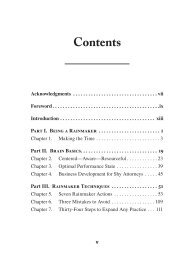(Bk Business) Carol Kinsey Goman Ph.D.-The Nonverbal Advantage_ Secrets and Science of Body Language at Work -Berrett-Koehler Publishers (2008)
Just
Just
Create successful ePaper yourself
Turn your PDF publications into a flip-book with our unique Google optimized e-Paper software.
132 <strong>The</strong> <strong>Nonverbal</strong> <strong>Advantage</strong><br />
University <strong>of</strong> Minnesota admitted th<strong>at</strong> they had found the<br />
money when asked. But if the researcher touched the elbow<br />
<strong>of</strong> the subject when inquiring about the coin, the percentage<br />
<strong>of</strong> those admitting possession rose to 68 percent—<strong>and</strong> they<br />
<strong>of</strong>ten looked embarrassed, with explan<strong>at</strong>ions like, “I was just<br />
looking around to see who lost the money.”<br />
High Touch<br />
We are programmed to feel closer to someone who’s touched<br />
us. <strong>The</strong> person who touches also feels more connected. It’s<br />
a powerful force, <strong>and</strong> even momentary touching can cre<strong>at</strong>e<br />
a human bond. A touch on the forearm th<strong>at</strong> lasts a mere<br />
one-fortieth <strong>of</strong> a second can make the receiver not only feel<br />
better but also see the giver as being kinder <strong>and</strong> warmer. <strong>The</strong><br />
person who’s been touched also perceives the environment<br />
as friendlier.<br />
<strong>The</strong> right kind <strong>of</strong> touch <strong>at</strong> the right time can even make<br />
you money! Research by the Cornell University School <strong>of</strong><br />
Hotel Administr<strong>at</strong>ion concludes th<strong>at</strong> being touched by servers<br />
increases the tips th<strong>at</strong> customers leave. At two informal<br />
restaurants, waitresses were assigned customers who were<br />
r<strong>and</strong>omly divided into three c<strong>at</strong>egories. Some customers<br />
were not touched <strong>at</strong> all, others were touched once on the<br />
shoulder for about one <strong>and</strong> a half seconds, <strong>and</strong> the rest were<br />
touched twice on the palm <strong>of</strong> the h<strong>and</strong> for about a half second<br />
each. All touches were given casually as the waitress<br />
returned change to the customer <strong>at</strong> the end <strong>of</strong> the meal. In<br />
all cases, eye contact was avoided.<br />
<strong>The</strong> results <strong>at</strong> both restaurants were significant. Customers<br />
who weren’t touched left an average tip <strong>of</strong> 12 percent.<br />
Tips increased to 14 percent from those who were touched<br />
on the shoulder <strong>and</strong> to 17 percent from those touched twice<br />
on the h<strong>and</strong>.




